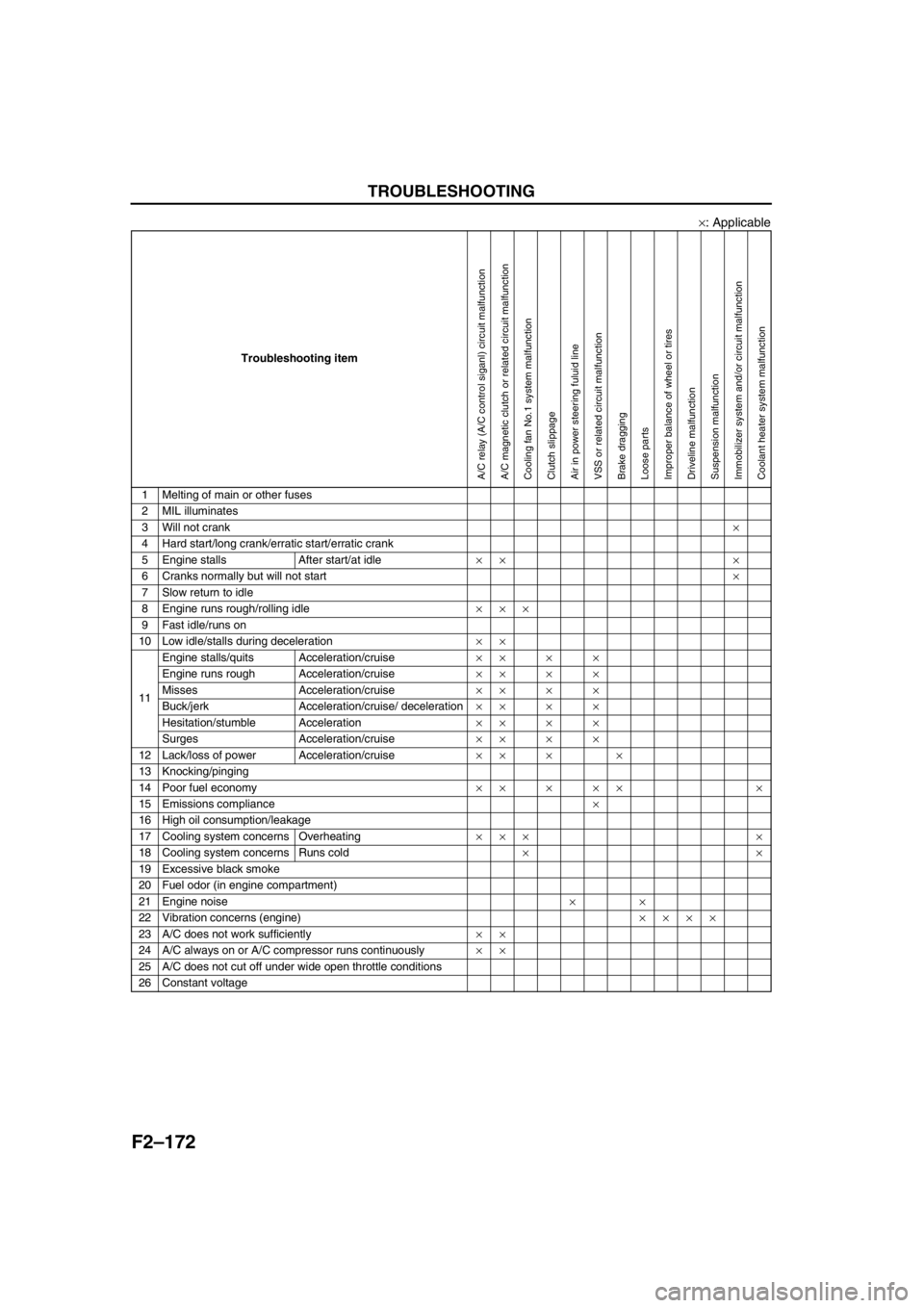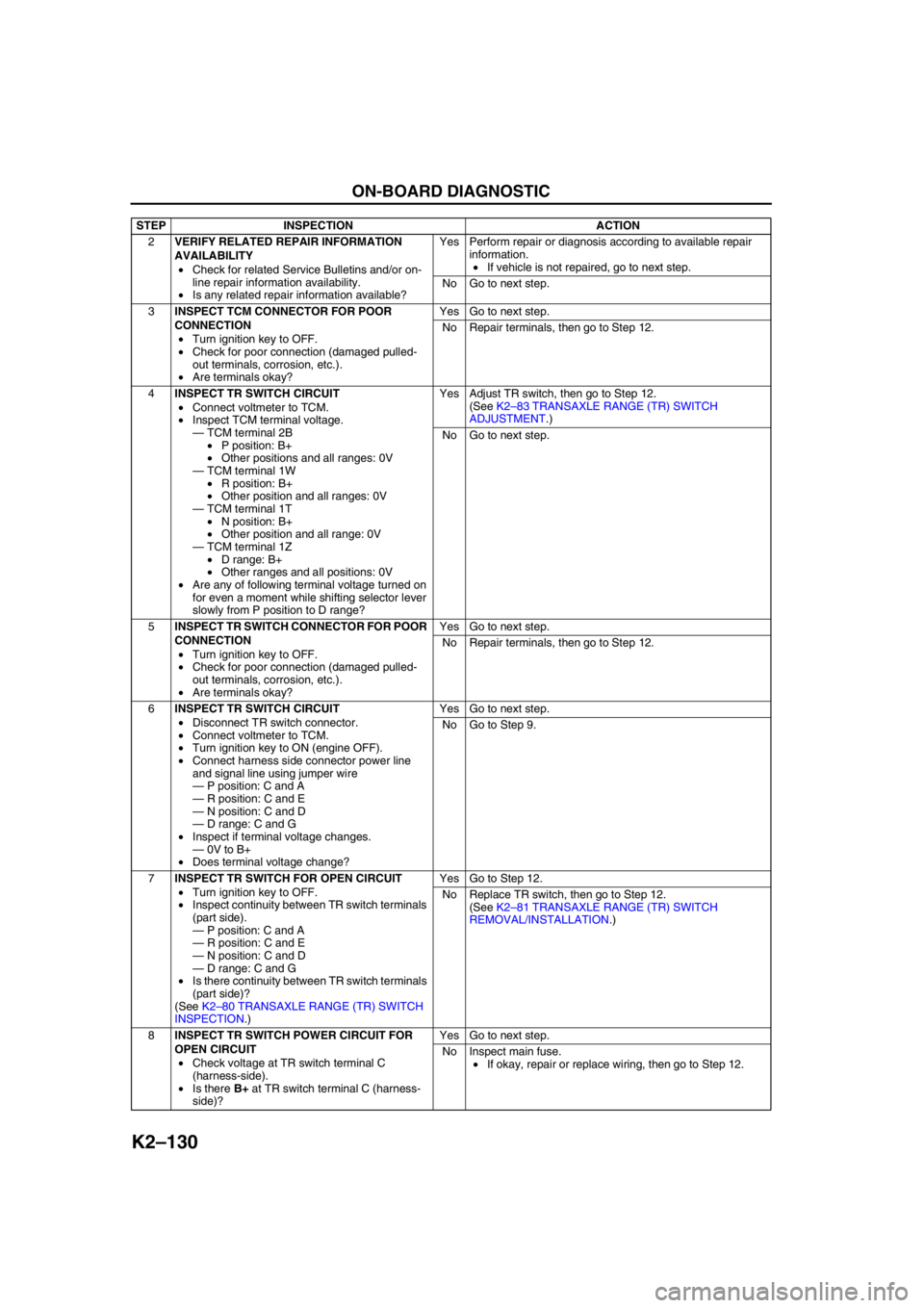fuse MAZDA 6 2002 Suplement Owner's Manual
[x] Cancel search | Manufacturer: MAZDA, Model Year: 2002, Model line: 6, Model: MAZDA 6 2002Pages: 909, PDF Size: 17.16 MB
Page 321 of 909

TROUBLESHOOTING
F2–169
F2
×: Applicable
Troubleshooting item
1 Melting of main or other fuses
2 MIL illuminates×× × ×
3 Will not crank
4 Hard start/long crank/erratic start/erratic crank×× ×××××××
5 Engine stalls After start/at idle×× ×××××××
6 Cranks normally but will not start×× ×××××××
7 Slow return to idle××××××××
8 Engine runs rough/rolling idle×××××××××
9 Fast idle/runs on×
10 Low idle/stalls during deceleration××××××××××
11Engine stalls/quits Acceleration/cruise× × ×××××××
Engine runs rough Acceleration/cruise× ××××××××××
Misses Acceleration/cruise× ××××××××××
Buck/jerk Acceleration/cruise/ deceleration× ××××××××××
Hesitation/stumble Acceleration× ××××××××××
Surges Acceleration/cruise× ×× ×××××××
12 Lack/loss of power Acceleration/cruise××× ×××××××××
13 Knocking/pinging××××× ××× × ×
14 Poor fuel economy××× ×××××× ×
15 Emissions compliance×××××××××××××
16 High oil consumption/leakage×
17 Cooling system concerns Overheating×
18 Cooling system concerns Runs cold
19 Excessive black smoke××× × ××× ×××
20 Fuel odor (in engine compartment)××
21 Engine noise× ××× ×
22 Vibration concerns (engine)
23 A/C does not work sufficiently
24 A/C always on or A/C compressor runs continuously
25 A/C does not cut off under wide open throttle conditions
26 Constant voltage
Turbocharger malfunctionCarge air cooler malfunctionVBC system malfunctionGlow system malfunctionIncorrect fuel injection timingIncorrect idle speedCKP sensor is damaged (e.g.: open or short circuits)CKP sensor pulse wheel is damagedImproper gap between CKP sensor and pulse wheelSupply pump malfunctionSuction control valve malfunctionFuel pressure limiter malfunctionFuel line restriction or clogging
Page 322 of 909

F2–170
TROUBLESHOOTING
×: Applicable
Troubleshooting item
1 Melting of main or other fuses
2 MIL illuminates××
3 Will not crank
4 Hard start/long crank/erratic start/erratic crank× × ××××× ×
5 Engine stalls After start/at idle×××××××××
6 Cranks normally but will not start× × ×××× × ×
7 Slow return to idle××××
8 Engine runs rough/rolling idle× × ×××× ××
9 Fast idle/runs on××
10 Low idle/stalls during deceleration× × ×××× ×
11Engine stalls/quits Acceleration/cruise× ××××× ×
Engine runs rough Acceleration/cruise× ××××× ×
Misses Acceleration/cruise× ××××× ×
Buck/jerk Acceleration/cruise/ deceleration× ××××× ×
Hesitation/stumble Acceleration× ××××× ×
Surges Acceleration/cruise× ××××× ×
12 Lack/loss of power Acceleration/cruise× ××××× ×
13 Knocking/pinging××××
14 Poor fuel economy×××××××
15 Emissions compliance× ×××××××
16 High oil consumption/leakage
17 Cooling system concerns Overheating×
18 Cooling system concerns Runs cold
19 Excessive black smoke××××
20 Fuel odor (in engine compartment)×
21 Engine noise××××
22 Vibration concerns (engine)×××
23 A/C does not work sufficiently
24 A/C always on or A/C compressor runs continuously
25 A/C does not cut off under wide open throttle conditions
26 Constant voltage×
Fuel injectors malfunction (Leakage or clogging,
inoperative)Fuel leakage from fuel system (including insulator,
fuel injector)Fuel filter restriction or cloggingCMP sensor is damaged (e.g: open or short circuit)CMP sensor pulse wheel is damagedIDM or related circuit malfunctionExhaust system restriction or cloggingCatalyst converter malfunctionEGR system malfunctionEGR water cooler malfunctionV-reference voltage supply circuit malfunction
Page 323 of 909

TROUBLESHOOTING
F2–171
F2
×: Applicable
Troubleshooting item
1 Melting of main or other fuses
2 MIL illuminates×××××× × ×××
3 Will not crank
4 Hard start/long crank/erratic start/erratic crank×× ×× ×
5 Engine stalls After start/at idle×× × × × ××
6 Cranks normally but will not start×× ×
7 Slow return to idle××× × × ×××
8 Engine runs rough/rolling idle××× × × ××××
9 Fast idle/runs on×××
10 Low idle/stalls during deceleration××× × × ××××
11Engine stalls/quits Acceleration/cruise× × × × ××××
Engine runs rough Acceleration/cruise××× × × ××××
Misses Acceleration/cruise× × × × ××××
Buck/jerk Acceleration/cruise/ deceleration× ×××× × ××××
Hesitation/stumble Acceleration× ×××× × ××××
Surges Acceleration/cruise× ×××× × ××××
12 Lack/loss of power Acceleration/cruise× ×××× × ××××
13 Knocking/pinging××××× ×
14 Poor fuel economy× ×××× ×××
15 Emissions compliance×××××× × ×××
16 High oil consumption/leakage
17 Cooling system concerns Overheating×
18 Cooling system concerns Runs cold
19 Excessive black smoke×× ×
20 Fuel odor (in engine compartment)×
21 Engine noise××××× ×
22 Vibration concerns (engine)×× ××××
23 A/C does not work sufficiently×
24 A/C always on or A/C compressor runs continuously
25 A/C does not cut off under wide open throttle conditions××
26 Constant voltage××××× ×
PCM control relay malfunctionECT sensor or related circuit malfunctionNeutral switch or related circuit malfunctionMAF/IAT sensor or related circuit malfunctionIAT sensor No.2 or related circuit malfunctionBoost sensor or related circuit malfunctionAccelerator position sensor or related circuit malfunctionAccelerator position sensor misadjustment
(including looseness)Idle switch or related circuit malfunctionIdle switch misadjustment (including looseness)Fuel pressure sensor or related circuit malfunctionImproper refrigerant charging amount
Page 324 of 909

F2–172
TROUBLESHOOTING
×: Applicable
End Of Sie
Troubleshooting item
1 Melting of main or other fuses
2 MIL illuminates
3 Will not crank×
4 Hard start/long crank/erratic start/erratic crank
5 Engine stalls After start/at idle×× ×
6 Cranks normally but will not start×
7 Slow return to idle
8 Engine runs rough/rolling idle×××
9 Fast idle/runs on
10 Low idle/stalls during deceleration××
11Engine stalls/quits Acceleration/cruise××××
Engine runs rough Acceleration/cruise××××
Misses Acceleration/cruise××××
Buck/jerk Acceleration/cruise/ deceleration××××
Hesitation/stumble Acceleration××××
Surges Acceleration/cruise××××
12 Lack/loss of power Acceleration/cruise×× × ×
13 Knocking/pinging
14 Poor fuel economy××××× ×
15 Emissions compliance×
16 High oil consumption/leakage
17 Cooling system concerns Overheating××× ×
18 Cooling system concerns Runs cold××
19 Excessive black smoke
20 Fuel odor (in engine compartment)
21 Engine noise××
22 Vibration concerns (engine)××××
23 A/C does not work sufficiently××
24 A/C always on or A/C compressor runs continuously××
25 A/C does not cut off under wide open throttle conditions
26 Constant voltage
A/C relay (A/C control siganl) circuit malfunctionA/C magnetic clutch or related circuit malfunctionCooling fan No.1 system malfunctionClutch slippageAir in power steering fuluid lineVSS or related circuit malfunctionBrake draggingLoose partsImproper balance of wheel or tiresDriveline malfunctionSuspension malfunctionImmobilizer system and/or circuit malfunctionCoolant heater system malfunction
Page 325 of 909
![MAZDA 6 2002 Suplement Owners Manual TROUBLESHOOTING
F2–173
F2
NO.1 MELTING OF MAIN OR OTHER FUSESA6E408018881203
End Of Sie
1 Melting of main or other fuses
[TROUBLESHOOTING HINTS]
Inspect condition of fuse.
Damaged fuse Related wiri MAZDA 6 2002 Suplement Owners Manual TROUBLESHOOTING
F2–173
F2
NO.1 MELTING OF MAIN OR OTHER FUSESA6E408018881203
End Of Sie
1 Melting of main or other fuses
[TROUBLESHOOTING HINTS]
Inspect condition of fuse.
Damaged fuse Related wiri](/img/28/57057/w960_57057-324.png)
TROUBLESHOOTING
F2–173
F2
NO.1 MELTING OF MAIN OR OTHER FUSESA6E408018881203
End Of Sie
1 Melting of main or other fuses
[TROUBLESHOOTING HINTS]
Inspect condition of fuse.
Damaged fuse Related wiring harness
MAINMAIN fuse
•BTN fuse
•FAN fuse
•AD FAN fuse
•IG KEY 2 fuse
IG KEY 1IG KEY 1 fuse
•Engine switch
—ENGINE fuse
FUEL PUMPFUEL PUMP fuse
•Fuel warmer
•PCM control relay
BTNBTN fuse
•ROOM fuse
IG KEY 2IG KEY 2 fuse
•Engine switch
ROOMROOM fuse
•DLC-2
ENGINEENGINE fuse
•PCM
INJINJ fuse
•PCM
•IDM
•MAF/IAT sensor
•VSC solenoid valve
•VBC solenoid valve
•EGR control solenoid valve
•EGR solenoid valve (vacuum)
•EGR solenoid valve (vent)
•Intake shutter solenoid valve (half)
•Intake shutter solenoid valve (full)
GLOWGLOW fuse
•Glow plug relay
—Glow plug
—GLOW SIG
ENG+BENG+B fuse
•PCM
FANFAN fuse
•Cooling fan relay No.2
AD FANAD FAN fuse
•Cooling fan relay No.1
Shorted harness
Repair shorted harness and replace fuseFuseDeterioration
Replace fuse
Page 327 of 909

TROUBLESHOOTING
F2–175
F2
End Of Sie
5 Is there continuity between PCM GND terminals
65, 85, 103, 104 and GND?Yes Go to next step.
No Repair or replace wiring harness.
6 Measure voltage between PCM GND terminals
65, 85, 103, 104 and coil terminal C.
Is the voltage below 1.0?Yes Go to next step.
No Repair or replace wiring harness.
7 Turn engine switch to ON.
Access VPWR PID.
Is VPWR PID okay?
Specification
Battery voltageYes Go to next step.
No Repair or replace wiring harness.
8 Disconnect coil connector.
Turn engine switch to ON.
Is there battery voltage at coil connector terminal
D (harness-side)?Yes Inspect for following:
•Open or short circuit between coil terminal A and
PCM terminal 80
•Open or short circuit between coil terminal B and
PCM terminal 28
No Repair or replace wiring harness between coil
connector terminal D and fuse panel.
9 Is there continuity between PCM terminal 57 and
starter relay?Yes Go to next step.
No Repair replace wiring harness.
10 Inspect following:
•Battery connection
•Battery condition
•Fuses
Are all items okay?Yes Go to next step.
No Service as necessary.
Repeat Step 10.
11 Is clicking sound heard from starter when engine
switch is turned to START?Yes Go to Step 13.
No Go to next step.
12 Inspect starting system.
Is starting system okay?Yes Inspect for seized/hydrolocked engine, flywheel.
No Repair or replace components as required.
13 Do any other electrical accessories work? Yes Go to next step.
No Inspect charging system.
14 Connect WDS or equivalent to DLC-2.
Turn engine switch to ON.
Retrieve any DTC.
Is DTC displayed?YesDTC is displayed:
Go to appropriate DTC test.
Communication error message is displayed:
Inspect for following:
•Open circuit between PCM control relay and PCM
terminal 53 or 79
•Open circuit PCM control relay and PCM terminal
69
•PCM control relay stuck open
•Open or poor GND circuit (PCM terminal 65, 85,
103 or 104)
•Poor connection vehicle body GND
NoNo DTC is displayed:
Inspect for following:
•START circuit in engine switch
•Open circuit between engine switch and starter
15 Verify test results.
•If okay, return to diagnostic index to service any additional symptoms.
•If malfunction remains, replace PCM. (See F2–64 PCM REMOVAL/INSTALLATION) STEP INSPECTION RESULTS ACTION
Page 331 of 909

TROUBLESHOOTING
F2–179
F2
4 Connect WDS or equivalent to DLC-2 and
retrieve DTC.
DTC
B1213, B1342, B1600, B1601, B1602, B1681,
B2103, B2431Yes Go to appropriate DTC test.
No Go to next step.
5 Is there continuity between PCM GND terminals
65, 85, 103, 104 and GND?Yes Go to next step.
No Repair or replace wiring harness.
6 Measure voltage between PCM GND terminals
65, 85, 103, 104 and coil terminal C.
Is the voltage below 1.0?Yes Go to next step.
No Repair or replace wiring harness.
7 Turn engine switch to ON.
Access VPWR PID.
Is VPWR PID okay?
Specification
Battery voltageYes Go to next step.
No Repair or replace wiring harness.
8 Disconnect coil connector.
Turn engine switch to ON.
Is there battery voltage at coil connector terminal
D (harness-side)?Yes Inspect for following:
•Open or short circuit between coil terminal A and
PCM terminal 80
•Open or short circuit between coil terminal B and
PCM terminal 28
No Repair or replace wiring harness between coil
connector terminal D and fuse panel.
9 Is there continuity between PCM terminal 57 and
starter relay?Yes Go to next step.
No Repair replace wiring harness.
10 Inspect for following:
•Fuel quality (e.g.: include water
contamination, winter/summer blend)
•Fuel line/fuel filter clogging
•Intake-air system restriction
Are all items okay?Yes Go to next step.
No Service as necessary.
Repeat Step 10.
11 Is engine overheating? Yes Go to symptom troubleshooting “NO.17 COOLING
SYSTEM CONCERNS-OVERHEATING”.
No Go to next step.
12Note
•Ignore DTC P0122, P0123, P0222 or
P0223 while performing this test.
Disconnect accelerator position sensor
connector.
Measure voltage at accelerator position sensor
connector VREF terminal (terminal D) with
engine switch ON.
Specification
4.5—5.5 V
Is voltage okay?Yes Go to next step.
No Go to symptom troubleshooting “NO.26 CONSTANT
VOLTAGE”.
13 Connect WDS or equivalent to DLC-2.
Turn engine switch to ON.
Retrieve any DTC.
Is DTC displayed?YesDTC is displayed:
Go to appropriate DTC test.
Communication error message is displayed:
Inspect for following:
•Open circuit between PCM control relay and PCM
terminal 53 or 79
•Open circuit PCM control relay and PCM terminal
69
•PCM control relay stuck open
•Open or poor GND circuit (PCM terminal 65, 85,
103 or 104)
•Poor connection vehicle body GND
NoNo DTC is displayed:
Go to next step.
14 Does engine start normally after warm-up? Yes Inspect glow system operation.
(See T–19 RELAY INSPECTION)
Replace any malfunctioning part as necessary.
If glow system is okay, go to next step.
No Go to next step. STEP INSPECTION RESULTS ACTION
Page 334 of 909

F2–182
TROUBLESHOOTING
3 Does security light illuminate? Yes Go to next step.
No Inspect instrument cluster and wiring harness.
4 Connect WDS or equivalent to DLC-2 and
retrieve DTC.
DTC
B1213, B1342, B1600, B1601, B1602, B1681,
B2103, B2431Yes Go to appropriate DTC test.
No Go to next step.
5 Is there continuity between PCM GND terminals
65, 85, 103, 104 and GND?Yes Go to next step.
No Repair or replace wiring harness.
6 Measure voltage between PCM GND terminals
65, 85, 103, 104 and coil terminal C.
Is the voltage below 1.0?Yes Go to next step.
No Repair or replace wiring harness.
7 Turn engine switch to ON.
Access VPWR PID.
Is VPWR PID okay?
Specification
Battery voltageYes Go to next step.
No Repair or replace wiring harness.
8 Disconnect coil connector.
Turn engine switch to ON.
Is there battery voltage at coil connector terminal
D (harness-side)?Yes Inspect for following:
•Open or short circuit between coil terminal A and
PCM terminal 80
•Open or short circuit between coil terminal B and
PCM terminal 28
No Repair or replace wiring harness between coil
connector terminal D and fuse panel.
9 Is there continuity between PCM terminal 57 and
starter relay?Yes Go to next step.
No Repair replace wiring harness.
10 Inspect for following:
•Fuel quality (e.g.: include water
contamination, winter/summer blend)
•Fuel line/fuel filter clogging
•Intake-air system restriction
Are all items okay?Yes Go to next step.
No Service as necessary.
Repeat Step 10.
11Note
•Ignore DTC P0122, P0123, P0222 or
P0223 while performing this test.
Disconnect accelerator position sensor
connector.
Measure voltage at accelerator position sensor
connector VREF terminal (terminal D) with
engine switch ON.
Specification
4.5—5.5 V
Is voltage okay?Yes Go to next step.
No Go to symptom troubleshooting “NO.26 CONSTANT
VOLTAGE”.
12 Connect WDS or equivalent to DLC-2.
Turn engine switch to ON.
Retrieve any DTC.
Is DTC displayed?YesDTC is displayed:
Go to appropriate DTC test.
Communication error message is displayed:
Inspect for following:
•Open circuit between PCM control relay and PCM
terminal 53 or 79
•Open circuit PCM control relay and PCM terminal
69
•PCM control relay stuck open
•Open or poor GND circuit (PCM terminal 65, 85,
103 or 104)
•Poor connection vehicle body GND
NoNo DTC is displayed:
Go to next step. STEP INSPECTION RESULTS ACTION
Page 389 of 909

G–6
CHARGING SYSTEM
BATTERY INSPECTIONA6E471018520202MZR-CD (RF Turbo)
Battery
1. Inspect the battery with the following procedure.
Load test chart
Battery positive voltage with load
Back-up Current
1. Verify that the engine switch is off and that the engine key has been removed.
2. Disconnect the negative battery cable.
Caution
•Operating electrical loads while measuring the back-up current can damage the circuit tester.
3. Measure the back-up current between the negative battery terminal and the negative battery cable.
(1) If the current exceeds the maximum, remove the fuses in the main fuse block and the fuse block one by
one while measuring the back-up current.
(2) Inspect and repair harnesses and connectors on the fuse where the current has been reduced.
Back-up current
20 mA max.
End Of Sie
BATTERY RECHARGINGA6E471018520203MZR-CD (RF Turbo)
Caution
•To avoid damage to the battery, do not quick charge for over 30 min.
•When disconnecting the battery, remove the negative cable first and install it last to prevent
damage to electrical components or the battery.
•To avoid deformation or damage to the battery, remove the battery plugs while charging the
battery.
Step Inspection Result Action
1Measure open circuit
voltage of battery.Above
12.4 VGo to Step
3.
Below
12.4 VGo to next
step.
2Quick-charge for 30 min.
and recheck voltage.Above
12.4 VGo to next
step.
Below
12.4 VReplace
battery.
3Apply load test (see load
test chart) to battery using a
battery load tester and
record battery voltage after
15 s. Is voltage more than
specification?YesBattery
okay.
NoReplace
battery.
Battery Load (A)
95D31L (64) 250
115D31L (70) 320
Approximate battery temp. Minimum voltage (V)
21°C {70°F} 9.6
15°C {60°F} 9.5
10°C {50°F} 9.4
4°C {40°F} 9.3
–1°C {30°F} 9.1
–7°C {20°F} 8.9
–12°C {10°F} 8.7
–18°C {0°F} 8.5
Page 545 of 909

K2–130
ON-BOARD DIAGNOSTIC
2VERIFY RELATED REPAIR INFORMATION
AVAILABILITY
•Check for related Service Bulletins and/or on-
line repair information availability.
•Is any related repair information available?Yes Perform repair or diagnosis according to available repair
information.
•If vehicle is not repaired, go to next step.
No Go to next step.
3INSPECT TCM CONNECTOR FOR POOR
CONNECTION
•Turn ignition key to OFF.
•Check for poor connection (damaged pulled-
out terminals, corrosion, etc.).
•Are terminals okay?Yes Go to next step.
No Repair terminals, then go to Step 12.
4INSPECT TR SWITCH CIRCUIT
•Connect voltmeter to TCM.
•Inspect TCM terminal voltage.
—TCM terminal 2B
•P position: B+
•Other positions and all ranges: 0V
—TCM terminal 1W
•R position: B+
•Other position and all ranges: 0V
—TCM terminal 1T
•N position: B+
•Other position and all range: 0V
—TCM terminal 1Z
•D range: B+
•Other ranges and all positions: 0V
•Are any of following terminal voltage turned on
for even a moment while shifting selector lever
slowly from P position to D range?Yes Adjust TR switch, then go to Step 12.
(See K2–83 TRANSAXLE RANGE (TR) SWITCH
ADJUSTMENT.)
No Go to next step.
5INSPECT TR SWITCH CONNECTOR FOR POOR
CONNECTION
•Turn ignition key to OFF.
•Check for poor connection (damaged pulled-
out terminals, corrosion, etc.).
•Are terminals okay?Yes Go to next step.
No Repair terminals, then go to Step 12.
6INSPECT TR SWITCH CIRCUIT
•Disconnect TR switch connector.
•Connect voltmeter to TCM.
•Turn ignition key to ON (engine OFF).
•Connect harness side connector power line
and signal line using jumper wire
—P position: C and A
—R position: C and E
—N position: C and D
—D range: C and G
•Inspect if terminal voltage changes.
—0V to B+
•Does terminal voltage change?Yes Go to next step.
No Go to Step 9.
7INSPECT TR SWITCH FOR OPEN CIRCUIT
•Turn ignition key to OFF.
•Inspect continuity between TR switch terminals
(part side).
—P position: C and A
—R position: C and E
—N position: C and D
—D range: C and G
•Is there continuity between TR switch terminals
(part side)?
(See K2–80 TRANSAXLE RANGE (TR) SWITCH
INSPECTION.)Yes Go to Step 12.
No Replace TR switch, then go to Step 12.
(See K2–81 TRANSAXLE RANGE (TR) SWITCH
REMOVAL/INSTALLATION.)
8INSPECT TR SWITCH POWER CIRCUIT FOR
OPEN CIRCUIT
•Check voltage at TR switch terminal C
(harness-side).
•Is there B+ at TR switch terminal C (harness-
side)?Yes Go to next step.
No Inspect main fuse.
•If okay, repair or replace wiring, then go to Step 12. STEP INSPECTION ACTION